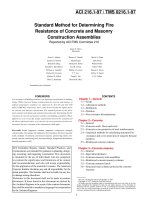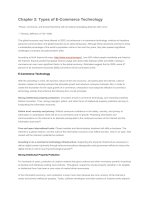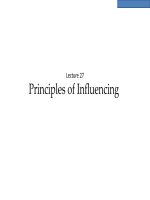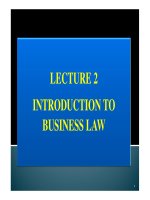CE 479 MASONRY LECTURE 2 COMPONENTS OF MASONRY, BONDING PATTERNS AND FIRE RESISTANCE AND DURABILITY
Bạn đang xem bản rút gọn của tài liệu. Xem và tải ngay bản đầy đủ của tài liệu tại đây (229.69 KB, 21 trang )
<span class="text_page_counter">Trang 1</span><div class="page_container" data-page="1">
<b>BASIC COMPONENTS OF MASONRY </b>
In the architectural history of masonry, we have seen that masonry can be used in a wide variety of architectural applications, including:
• walls (bearing, shear, structural, decorative, bas-relief, mosaic) • arches, domes and vaults
• beams, columns
Masonry, while often simple and elegant in form, can be complex in behavior. Also, unlike concrete, it cannot be ordered by the cubic yard. To understand its behavior, and to be able to specify masonry correctly, we must examine each of its basic components.
<b>Basic Components of Masonry: </b>
Masonry units, as noted below, can be classified as: • adobe (unfired clay)
• roofing tile • drain tile • refractory brick • wall tile
• glazed facing tile (terra cotta, ceramic veneer) • structural clay products
• brick (solid, frogged, cored, hollow) o facing and building brick
</div><span class="text_page_counter">Trang 2</span><div class="page_container" data-page="2">• concrete block (solid, hollow) • glass
• stone (artificial shape) • rock (natural shape)
In this course, we shall emphasize the behavior and use of structural masonry units, of fired clay or of concrete.
<b>Mortar </b>
In the US, three basic cementitious systems are used for mortar: portland cement-lime mortar; masonry cement mortar; and mortar cement mortar. The first two are widely used; the third has been recently introduced.
<i>• Portland Cement-Lime Mortar (different proportions of portland cement, lime and </i>
masonry sand). This can be batched by hand on site using material from bags, or batched automatically on site using material from silos.
<i>• Masonry-Cement Mortar (different proportions of masonry cement and sand; may also </i>
contain additional portland cement). Masonry cement formulations and manufacturing processes are manufacturer-specific. Ingredients are not required to be identified, and usually are not. Masonry cement generally consists of portland cement, pozzolan cement or slag cement, plasticizing additives, air-entraining additives, water-retention additives, and finely ground limestone (added primarily as a filler, but with some plasticizing and cementitious effect).
<i>• Mortar-Cement Mortar (different proportions of mortar cement and sand; may also </i>
contain additional portland cement). Mortar cement formulations and manufacturing processes are manufacturer-specific. Ingredients are not required to be identified, and usually are not. Mortar cement generally consists of portland cement, pozzolan cement or slag cement, plasticizing additives, air-entraining additives, water retention additives, and finely ground limestone (added primarily as a filler, but with some plasticizing and cementitious effect). It differs from masonry cement in that it is formulated specifically for tensile bond strength comparable to that of portland cement-lime mortar.
<b>Grout </b>
Grout is fluid concrete with pea-gravel aggregate. It can be used to fill some or all cells in hollow units, or between wythes.
<b>Accessory Materials </b>
• Reinforcement
• Connectors (galvanized or stainless steel) • ties connect a masonry wall to another wall • anchors connect a masonry wall to a frame
• fasteners connect something else to a masonry wall • Sealants
• expansion joints (brick masonry)
</div><span class="text_page_counter">Trang 3</span><div class="page_container" data-page="3">• control joints (concrete masonry)
Masonry unit dimensions are typically described in terms of (thickness x height x length). Typically, the length is the largest dimension; the thickness is next; and the height is the smallest dimension. For example, a typical brick has dimensions of 4 x 2.67 x 8 inches. These are
<b>nominal dimensions; that is, the distances occupied by the unit plus one-half a joint width on each side. Joints are normally 3/8 in. thick. The specified dimensions of the brick themselves are smaller; in this case, 3-5/8 x 2-1/4 x 7-5/8 in. The actual dimensions are the specified </b>
dimensions plus or minus the allowable manufacturing tolerance.
The sides of a masonry unit are often designated in literature by special names:
<i>• bed: side formed by thickness x length • face: side formed by height x length </i>
<i>• head: side formed by thickness x height (end) </i>
Orientation of Masonry Units in a Wall: all figures below are viewed perpendicular to the plane of the wall:
</div><span class="text_page_counter">Trang 4</span><div class="page_container" data-page="4"><b>Bond Patterns: </b>
</div><span class="text_page_counter">Trang 5</span><div class="page_container" data-page="5"><b>Types of Walls: </b>
• single wythe: barrier wall
• multiple wythe: composite wall (brick-block) • filled collar joint
• bonded headers
• cavity wall (cavity P 2 inches wide) • brick veneer over concrete block backup
• brick veneer over steel stud
</div><span class="text_page_counter">Trang 6</span><div class="page_container" data-page="6"><b>Modern Masonry Mortar </b>
Modern masonry mortar is composed of cementitious agent (portland cement or other hydraulic cements and hydrated lime, or masonry cement, or mortar cement), sand, and water. Each of these can be referred to as a masonry system. These masonry systems are defined by ASTM C 270. That specification defines, for all masonry systems, different masonry types. In general, these are distinguished by the amount of portland cement that they use.
<b>Types of Masonry Mortar: </b>
Types of masonry mortar are designated as shown below. The letters M, N, S, and O represent every second letter of the phrase, “mason work:”
M, S, N, O (M A S O N W O R K )
This designation was selected intentionally (rather than, for example, “A, B, C, D”), to avoid the implication that a “Type A” mortar would always be the best.
<b>Characteristics of Different Types of Masonry Mortar </b>
• Type M: high compressive strength and tensile bond strength • Type S: moderate compressive and tensile bond strength • Type N: low compressive strength and tensile bond strength • Type O: very low compressive and tensile bond strength
• Type K: no longer used
<b>Proportions of Portland Cement Lime Mortar </b>
</div><span class="text_page_counter">Trang 7</span><div class="page_container" data-page="7"><b>Portland Cement-lime Mortar Specifications </b>
<b>Proportions Masonry Cement Type Mortar </b>
The first four are the more common specifications for this type of mortar.
</div><span class="text_page_counter">Trang 8</span><div class="page_container" data-page="8"><b>Property Specifications of Masonry Cement Mortar </b>
<b>Mortar Cement Mortar Proportion Specifications </b>
<b>Property Specifications of Mortar Cement Mortar </b>
</div><span class="text_page_counter">Trang 9</span><div class="page_container" data-page="9"><b>Characteristics of Fresh Mortar: </b>
<b>Workability (ease of being spread under a trowel) is described in terms of flow: a </b>
standard-shaped, circular sample of mortar 4 inches in diameter is placed on a flow table, which is then dropped 25 times. The flow is defined as the increase in diameter, divided by the original diameter and multiplied by 100. Thus, if the final diameter is 8 inches, the flow is (8 - 4) / 4, or 100. Laboratory-mixed mortars have a flow of about 110 ± 5; field mortars, about 130 to 150.
<b>Field mortars should be re-tempered (water added) as necessary to maintain workability, but </b>
should not be used beyond 2-1/2 hours after mixing. Workability can also be measured with a cone penetrometer.
According to ASTM C270, mortar can be specified by proportion (the default) or by property. If mortar is specified by proportion, the following characteristics of fresh mortar are controlled indirectly as a result of complying with the required proportions. If mortar is specified by property, they are controlled directly:
1) retentivity: this is the ratio of the flow after suction to the initial flow. Flow after suction is measured using mortar from which some of the water has been removed using a standard vacuum apparatus. In one other specification, the mortar is spread on a masonry unit and allowed to sit for 1 minute. According to ASTM C270, mortar is required to have a retentivity of at least 75%.
2) air content: percent air by volume (C 91). Portland cement-lime mortar and mortar cement mortar usually have a maximum permissible air content of 12%. Masonry cement mortar usually has a maximum air content of 18% if used in reinforced masonry.
<b>Characteristics of Hardened Mortar: </b>
These include compressive strength and tensile bond strength. Only the first is controlled by ASTM C270. If mortar is specified by the property specification of ASTM C 270, compressive strength is controlled directly. It is measured using 2-inch mortar cubes, made with laboratory flow mortar, cured for 28 days under standard conditions of 100% relative humidity and 70 F. It typically ranges from 500 to 3000 psi. It does not significantly affect the compressive strength of masonry assemblages (see below). ASTM C 270 requires minimum compressive strengths of 2500 psi, 1800 psi, 750 psi, and 350 psi for Type M, S, N, and O mortar, respectively.
If mortar is specified by the proportion specification of ASTM C 270, compressive strength is controlled indirectly. Masonry cement mortar meeting the proportion specification usually has a compressive strength slightly greater than the minimum value specified in the property
specification. Portland cement lime mortar meeting the proportion specification usually has a compressive strength considerably greater than the minimum value specified in the property specification.
<b>Note on Portland Cement-Lime versus Masonry Cement Mortars </b>
At times in the past, and to some extent even to this day, controversy has existed within the masonry technical community over the comparative performance of portland cement-lime mortar and masonry cement mortar. Each class of mortar has advantages and disadvantages.
</div><span class="text_page_counter">Trang 10</span><div class="page_container" data-page="10"><i><b>The advantages of portland cement-lime mortar are its high tensile bond strength, and the </b></i>
generally higher water-penetration resistance of masonry laid using it. Its disadvantages are the additional complexity of mixing three ingredients, and some lack of workability (stickiness) if not re-tempered. The first disadvantage can be overcome by single-bag or silo mixes. The second can sometimes be overcome by re-tempering.
<i><b>The advantages of masonry cement mortar are its relative simplicity of batching and its good </b></i>
workability. It has a “fluffy” consistency (because of its entrained air), which leads to good productivity. Its lower tensile bond strength is accounted for by lower allowable stresses in design codes. In part because of these lower bond strengths, and in part because of other reasons,
masonry cement is prohibited in zones of high seismic risk in the US. Lower water-penetration resistance of walls made with masonry cement mortar is not addressed. From the viewpoint of cement producers, masonry cement is a profitable “niche” product. A 70-lb bag of masonry cement typically contains about 28 lb or less of portland cement, about 40 lb of ground limestone, air-entraining additives, and possibly additives for water-retention and plasticity. This bag
commonly sells for the same price as 94 lb of portland cement.
<i><b>Mortar cement was introduced in the 1990’s to preserve the construction advantages and </b></i>
potential profitability of masonry cement, while at the same time increasing the tensile bond strength of the resulting mortar to values comparable to those of portland cement-lime mortar. Mortar cement is regarded by building codes as the equivalent of portland cement-lime mortar, and is permitted even in the most seismic zones of the US.
<b>MASONRY GROUT </b>
Masonry grout is essentially fluid concrete. It is used to fill spaces in masonry, and to surround reinforcement and anchors.
<b>Applicable ASTM Specification: </b>
C476: Grout for Masonry
Grout for masonry is composed of portland cement, sand, and pea gravel. It is permitted to contain a small amount of hydrated masons' lime, but usually does not. It is permitted to be specified by proportion or by property.
<b>Proportion specifications for grout for masonry: </b>
</div><span class="text_page_counter">Trang 11</span><div class="page_container" data-page="11"><b>Properties of Fresh Grout: </b>
Masonry grout is placed with a slump of at least 8 inches, so that it will flow freely into the cells of the masonry. Because of its high water-cement ratio at time of grouting, masonry grout undergoes considerable plastic shrinkage as the excess water is absorbed by the surrounding units. To prevent the formation of voids due to this process, the grout is consolidated during placement, and re-consolidated after initial plastic shrinkage. Grouting admixture such as Sika's "Grout-Aid," which contain plasticizers and water-retention agents, are also useful in the grouting process.
<b>Properties of Hardened Grout: </b>
The most important property of hardened grout is its compressive strength. If grout is specified by property, it must have a compressive strength of at least 2000 psi. If it is specified by proportion, its compressive strength is controlled indirectly to at least that value, by the ingredients used. Because of its high water-cement ratio at the time of grouting, masonry grout cast into impermeable molds has a very low compressive strength, which is not representative of its strength under field conditions, when the surrounding units absorb water from it. For this reason, ASTM C 1019 (Compressive Strength of Grout) requires that the compression specimen be cast using a permeable mold. The most common way of preparing such a mold is to arrange masonry units so that they enclose a block whose base is 2 inches square, and whose height is equal to the height of the units. The block is surrounded by paper towels or filter paper, so that the
compressive specimen's water-cement ratio is similar to that of grout in the actual wall.
<b>CLAY MASONRY UNITS Geology: </b>
Bricks are formed of clay, a sedimentary mineral. Clay is found in the form of surface clay, shale (naturally compressed and hardened clay), or fire clay (deeper clays). In the United States, clay is found primarily in central Texas and the east coast, although small amounts are found in
sedimentary deposits throughout the country.
<b>Chemistry: </b>
Clays and shales are about 65% silicon oxide and 20% aluminum oxide. They may also contain varying amounts of other metallic oxides (manganese, phosphorus, calcium, magnesium, sodium, potassium and vanadium). These metallic oxides give a brick a distinctive color, decrease the brick's vitrification temperature, and also affect its appearance and durability. For example, small amounts of chromite, added to light-colored (buff) clay, will give it a gray color; small amounts of manganese, added to buff clay, will give it a brown color.
<b>Manufacturing: </b>
Three processes are in use today:
1) soft mud process: clay containing 20% - 30% water by weight is molded.
</div><span class="text_page_counter">Trang 12</span><div class="page_container" data-page="12">2) stiff mud process: clay containing 12% - 15% water by weight is mixed, forced through a die, and cut with wire. This is the most common process in the United States.
3) dry press process: mix clay containing 7% - 10% water by weight, form in hydraulic press. This process is rare.
After forming, various surface textures can be imparted to the brick: wire-cut; rug (heavy scratches); matte (light scratches); or sand finished. The brick are then placed on specially insulated railway cars, and subjected to the firing process. This involves 6 basic steps:
1) Pre-heating: The green brick are dried at about 350 F, in drying ovens heated by exhaust gases from the kiln. During this process, the brick shrink. The brick then move into a tunnel kiln, which is kept relatively cool at the entrance, hot in the middle, and cooler again at the exit. The heat comes from burning fuel within the kiln itself. Over a period of 12 hours to as long as 3 days, the brick pass from the entrance to the hottest section, and then to the cooler exit. Temperatures in the different sections are regulated to produce different results. The brick pass through the following steps:
2) Dehydration: The brick continue to dry at temperatures from 300 F to about 800 F. 3) Oxidation: At temperatures from about 800 F to 1800 F, organic material burns.
4) Vitrification (or incipient vitrification): At temperatures of 1600 F to 2400 F, the clay begins to vitrify. Silicates in the clay begin to fuse, binding the unvitrified clay particles together. This point is termed “incipient fusion.” The temperature used depends on the type of clay. Most clays will undergo incipient fusion at about 2000 F. The purest clays, which are used for refractory brick, are fired at temperatures up to 2400 F.
5) Control of Oxygen: The color of metallic oxides can be changed by feeding additional air into the kiln at this point, or by intentionally withholding air. The latter is termed “flashing.”
6) Cooling: The brick are then slowly cooled.
<b>Visual and Serviceability Characteristics: </b>
The following characteristics are covered by ASTM C62 (Standard Specification for Building Brick) or by ASTM C216 (Standard Specification for Facing Brick):
Compressive strength varies from 1,200 to 30,000 psi. It is typically 8,000 to 15,000 psi. Building brick (ASTM C62) must have a minimum compressive strength (average of 5 units, tested
flatwise) of 1500 psi for Grade NW (normal weathering), 2500 psi for Grade MW (moderate weathering), and 3000 psi for Grade SW (severe weathering). Building brick (ASTM
</div>








